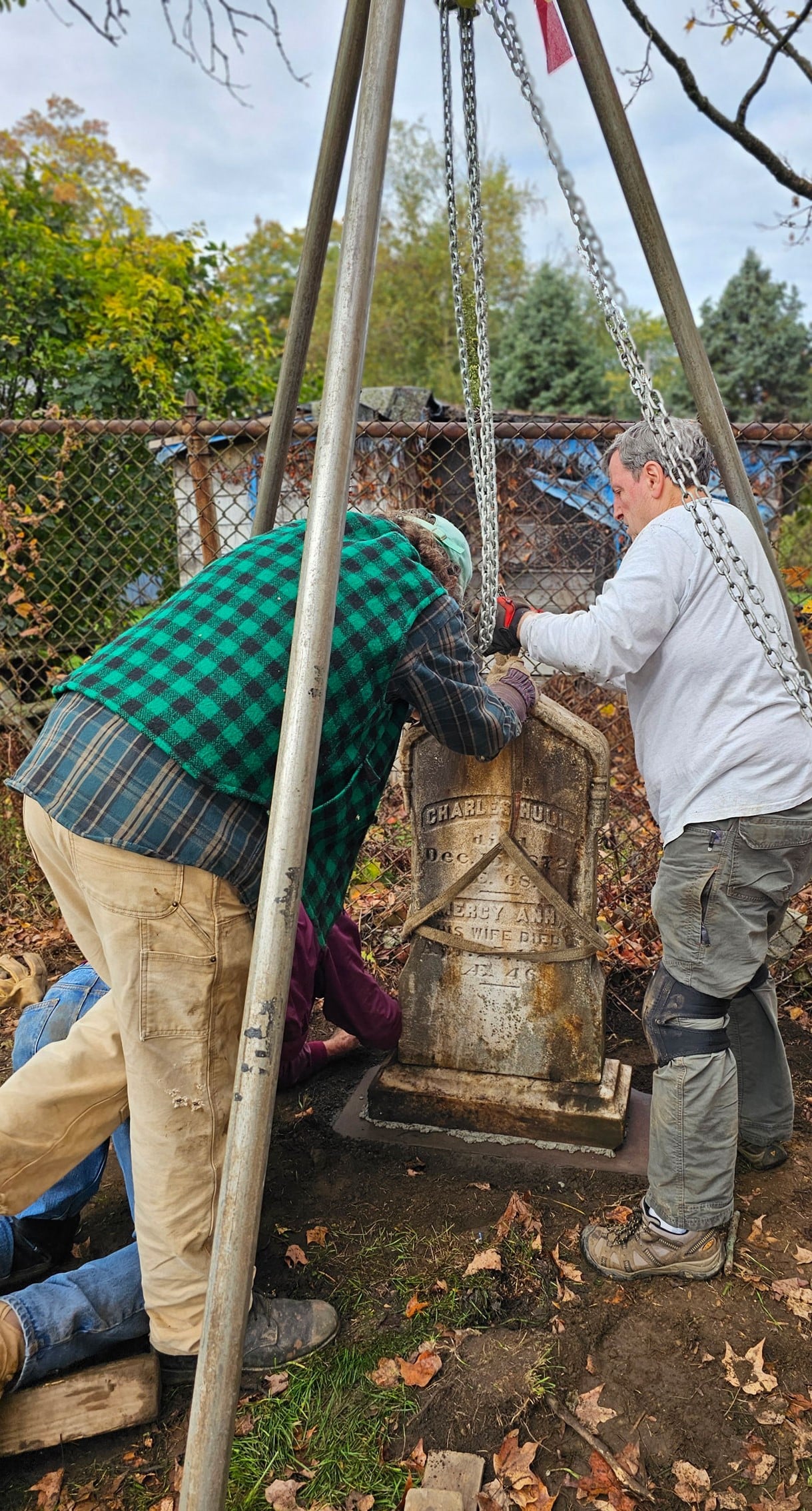Veterans who work with the city’s graves officer use a tripod and chain hoist to place a headstone back onto its base at the Old Burying Ground (Mechanic Street Cemetery).
Reminder Publishing submitted photo
WESTFIELD — For Gene Theroux, one of the three staff working for the Westfield Veterans Services, nearly every day is Veterans Day. The city’s graves officer, he’s always at one of the city’s nine cemeteries checking conditions of veterans’ gravestones or repairing them.
“I’m in a cemetery almost every single day of the week, all year long,” said Theroux who has been the graves officer for the past six years. “We’ve stopped doing preservation work in the cemeteries for the season, so I’ll be putting out flag holders or doing something else.”
Massachusetts requires cities and towns to designate a person to take care of veterans’ graves. Theroux said that before he was hired, there were designated points of contacts in cemeteries to ensure American flags were provided to place on veterans’ graves for Memorial Day.
Theroux still facilitates getting flags and is now replacing old plastic flag holders placed at graves.
“We’ve budgeted to replace them because they break, fall apart, fade and spin in the wind. The new metal ones are for various armed forces as well as for Purple Heart recipients, prisoners of war and MIAs as appropriate,” Theroux said.
He said the new flag staffs are solid, strong and won’t bend. “What’s really nice about these is that they have stops so they won’t twist in the wind. When you look at them in a row, they’re all perfect and uniform.”
However, his passion — and where he concentrates most of his work — is gravestone preservation.
“I work with a team of volunteers who are veterans. We do a lot more than what most cities and towns do to take care of veterans’ graves. We don’t just clean the gravestones, we repair, level and plumb them,” he said.
Theroux also surveys the cemeteries to document where veterans’ graves, are located, maintaining the information in a database.
“I put in GPS coordinates so they can map it. During the winter, I document work that’s been accomplished, who did the work and edit photos of our work,” he said.
The retired Air Force veteran who was responsible for systems analyst and communications, archives all photos by date and by cemetery, so he can easily go back and look at them to update his database. He also uses the photos for a PowerPoint presentation when doing public outreach at various events.
Theroux said it would cost an average of $500 to repair a gravestone if he hired professional conservators.
“Our budget allocates $15,000 for the entire year for repairs, which we would exceed if we hired professionals. I only hire professionals for jobs that are beyond our capability or if we don’t have the equipment. It’s still very expensive to do this work, even with my volunteer team — all the consumables we use to repair the gravestones is very expensive,” he said.
His team of five to 10 veterans each get a property tax credit of $1,500 for the work they do.
“I’ve taught them how to be conservators, They’re very dedicated. They’ve done some fantastic work. They’re not doing it for the tax compensation. They’re doing it because they like what they’re doing and they feel it’s important to maintain veterans’ gravesites to make sure veterans are not only honored and remembered, but also that their legacies go forward for generations to appreciate,” said Theroux.
He said gravestones usually fail because bases become unlevel or the mortar dries out.
“The first thing we have to do is know what’s a contributing factor. If the mortar has dried out, it’s just requires using a setting compound. There’s really nothing adhering, it’s held by weight. The setting compound keeps water and bugs out,” he said.
The key thing is to get the base level and plumb. Theroux uses crushed grave to repair a base. Once it’s level, plumb and secure, he lines it up so it’s aligned perfectly with other gravestones in that row. He said it’s also good to have the base above the surface of the ground to prevent it from getting scored when cemetery workers mow or use string trimmers.
“Then we’ll mix the lime mortar and place the gravestone back on top of the base. We also have a woman who cleans pieces of the gravestones prior to us putting it back together. We try to get it all done in one day,” said Theroux.
He said the priority for fixing gravestones are those that are safety hazards, are of historical value or are leaning.
“Marble tablets in particular are direct buries, so if they’re leaning, then they develop stress cracks at the bottom,” said Theroux. “If you don’t do something about it, within a year, two years, it’s going to be snapped and it’s going to be laying on the ground.”
A Southwick resident, Theroux serves as chair of its Cemetery Commission, so he repairs veterans’ graves for the town.
“Over the last four years, I’ve written community preservation grants for both Southwick and Westfield that exceed $600,000. The most recent one in Southwick was to remove 77 hazardous trees in the Old Cemetery,” he said.
In addition to documenting repairs, Theroux also tries to record as much information as possible about veterans who names are on the gravestones.
“I have subscriptions to a number of search engines, so I can find the date that they enlisted and the date they mustered into what unit, what company, if they were wounded or if they were a prisoner of war. Everybody has a story to tell — I try to tell those of veterans buried in Westfield,” Theroux said.


